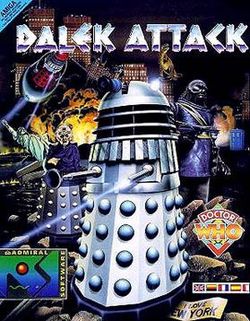Dalek Attack
| Dalek Attack | |
|---|---|
 |
|
| Developer(s) | Admiral Software |
| Publisher(s) | Admiral Software |
| Platforms | IBM PC, ZX Spectrum, Commodore 64, Amiga, Atari ST.[1] |
| Release date(s) | October, 1992 |
| Genre(s) | Platform game |
| Mode(s) | Single player, Co-op |
Dalek Attack is a computer game based on the long-running British science fiction television series Doctor Who, in which the player controls the Doctor and fights recurring adversaries, the Daleks and other enemies. In most versions of the game, the player can choose between playing as the Fourth, Fifth or Seventh Doctor; in the MS-DOS and Amiga versions, the player can play as the Second, Fourth or Seventh Doctor, and in the ZX Spectrum version only the Seventh Doctor was available.[2] A second player may play as the Doctor's companion (Ace or a UNIT soldier, although in the Spectrum version only Ace is available). K-9 also makes appearances later in the game as does Davros, creator of the Daleks in the TV series, as the final end of level boss.[2] The game is set in London, Paris, New York, Tokyo and Skaro.[3]
The game was released on all major formats of the time except for the Amstrad CPC, which was announced but never released. It was designed and storyboarded by 221B Software Development. Graphics were by John Gyarmati and Wayne Dalton. Nick Kimberley programmed the PC, Spectrum and (unreleased) Amstrad versions. The Amiga and Atari ST versions were programmed by Richard Turner. Jason Heggie was in charge of the Commodore 64 version. Music was by Paul Tankard.[3] On the PC and Amiga versions, there was a secret room behind some blocks. The room gave some of the programming credits for each game, in particular the graphics and music. The credits were hidden in this way due to the BBC not wanting individual credits for the game development team to be included in the game. Perhaps surprisingly, the PC version, which had the most sophisticated graphics, and the ZX Spectrum version, the most basic version, were both coded by the same person.[citation needed] This was due to the similarities between Z80 and 8086 assembly language.
Alternative Software released the ZX Spectrum version only due to popular demand, since by 1992 the Spectrum was no longer a commercially viable platform.[4][5] Dalek Attack was released for the Spectrum in 1993,[5] and was the last licensed Spectrum game.[2] It differed from all the others in its first level; in all the other releases the first level involved the Doctor on a hoverboard going along the sewer. The Spectrum version had the Doctor on foot running around collecting hostages and avoiding globes. The Spectrum version also lost out on other features such as different enemies; only the Robomen, Ogrons and standard Daleks featured.[6] The end-level guardians were also different. Before its release Spectrum owners who wrote to Alternative software pressing for a release received a letter back stating that the game was in production, and were sent a sticker depicting the game's box front emblazoned with the legend "I've Been Exterminated!"[citation needed]
Other versions of the game featured special Daleks such as hovering Daleks from the TV Century 21 comics strips of the 1960s. 1960s "movie" Daleks also made an appearance, as did the special weapons Dalek from Remembrance of the Daleks. Another special Dalek also featured, based on a sketch in an article from the Doctor Who Magazine 10th anniversary special showing how a Dalek might look when the television series came back.
The game was later re-released, first in a three pack compilation set called the Sci-Fi Collection with two other titles (Galactic Warrior Rats, Suburban Commando) for the PC. The front cover was in a "Y" shape with Dalek Attack in the bottom right and the instruction booklet was photocopied. This was followed in 1994/95 by another re-release, which was the same as the original except for a purple and black border added to the front and back covers.
References
- ↑ Lua error in package.lua at line 80: module 'strict' not found.
- ↑ 2.0 2.1 2.2 Lua error in package.lua at line 80: module 'strict' not found.
- ↑ 3.0 3.1 Lua error in package.lua at line 80: module 'strict' not found.
- ↑ Lua error in package.lua at line 80: module 'strict' not found.
- ↑ 5.0 5.1 Lua error in package.lua at line 80: module 'strict' not found.
- ↑ Lua error in package.lua at line 80: module 'strict' not found.
External links
- Dalek Attack at MobyGames
- Dalek Attack at World of Spectrum
- Dalek Attack at Lemon 64
- Articles with unsourced statements from January 2010
- Articles with unsourced statements from June 2015
- Daleks
- 1992 video games
- Video games based on Doctor Who
- DOS games
- ZX Spectrum games
- Commodore 64 games
- Amiga games
- Atari ST games
- Cancelled Amstrad CPC games
- Second Doctor stories
- Fourth Doctor stories
- Seventh Doctor stories
- Dalek stories
- Doctor Who multi-Doctor stories